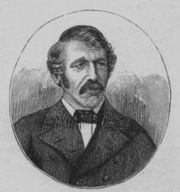David Livingstone
2007 Schools Wikipedia Selection. Related subjects: British History 1750-1900; Geographers and explorers
| Livingstone | |
|---|---|
|
missionary and explorer
|
|
| Born | 19 March 1813 Blantyre, Scotland |
| Died | 1 May 1873 near Lake Bangweulu, Zambia |
David Livingstone ( 19 March 1813 – 1 May 1873) was a Scottish medical missionary and explorer in central Africa. He was the first European to see Victoria Falls, which he named. He is perhaps best remembered because of his meeting with Henry Morton Stanley, which gave rise to the popular quotation, "Dr. Livingstone, I presume?"
Early life
David Livingstone was born on March 19, 1813 in the village of Blantyre, South Lanarkshire, Scotland, into a family believed to be descended from the highland Livingstones, a clan that had been previously known as the Clan MacLea. He first studied Greek, medicine, and theology at the University of Glasgow and while working in London, he emulated the example of another Scot, Robert Moffat, and joined the London Missionary Society, becoming a minister.
Livingstone originally planned to gain access to China through his medical knowledge (healing arts). The Opium Wars, which were raging at this stage with no signs of peace on the horizon, forced Livingstone to consider other options. Moffat seemed to have found an "inviting field" in Africa and Livingstone turned his thoughts there.
From 1840 he worked in Bechuanaland (now Botswana), but was unable to make inroads into South Africa because of Boer opposition.
He married Mary Moffat, daughter of Robert Moffat, in 1845, and she travelled with him for a brief time at his insistence, despite her pregnancy and the protests of the Moffats. She later returned to England with their children.
In the period 1852– 56, he explored the African interior, and was the first European to see the Mosi-oa-Tunya ("the smoke that thunders") waterfall (which he renamed Victoria Falls after his monarch, Queen Victoria). Livingstone was one of the first Westerners to make a transcontinental journey across Africa. The purpose of his journey was to open the routes, while accumulating useful information about the African continent. In particular, Livingstone was a proponent of trade and Christian missions to be established in central Africa. His motto, inscribed in the base of the statue to him at Victoria Falls, was "Christianity, Commerce and Civilisation." At this time he believed the key to achieving these goals was the navigation of the Zambezi River. He returned to Britain to try to garner support for his ideas, and to publish a book on his travels. At this time he resigned from the London Missionary Society, to which he had belonged.
Zambezi expedition
Livingstone returned to Africa as head of the " Zambezi Expedition", which was a British government-funded project to examine the natural resources of southeastern Africa. The Zambezi river turned out to be completely unnavigable past the Cabora Bassa rapids, a series of cataracts and rapids that Livingstone had failed to explore on his earlier travels.
The expedition lasted from March 1858 until the middle of 1864. Livingstone was an inexperienced leader and had trouble managing a large-scale project. The artist Thomas Baines was dismissed from the expedition on charges (which he vigorously denied) of theft. Livingstone's wife Mary died on 29 April 1863 of malaria, but Livingstone continued to explore, eventually returning home in 1864 after the government ordered the recall of the Expedition. The Zambezi Expedition was castigated as a failure in many newspapers of the time, and Livingstone experienced great difficulty in raising funds further to explore Africa. Nevertheless, the scientists appointed to work under Livingstone, John Kirk, Charles Meller, and Richard Thornton did contribute large collections of botanic, ecological, geological and ethnographic material to scientific institutions in the UK.
Illness, pain and death
Livingstone was taken ill and completely lost contact with the outside world for six years. Only one of his 44 letter dispatches made it to Zanzibar. Henry Morton Stanley, who had been sent in a publicity stunt to find him by the New York Herald newspaper in 1869, found Livingstone in the town of Ujiji, on the shores of Lake Tanganyika, in October 1871. Stanley joined Livingstone, and together they continued exploring the north end of the Tanganyika (the other constituent of the present Tanzania), until Stanley left in March the next year.
Despite Stanley's urgings, Livingstone was determined not to leave Africa until his mission was complete. His illness made him confused and he had judgment difficulties at the end of his life. He accepted help from Arab slave merchants, looking to capture slaves. They used him to facilitate contact with local people. He died there, in Chief Cazembe's village on the southern shores of Lake Bangweulu (now in Zambia), on 1 May 1873 from malaria and internal bleeding caused by dysentery. Livingstone's heart was buried under a Mvula tree near the spot where he died. His body, carried over a thousand miles by his loyal attendants Chuma and Susi, was returned to Britain for burial in Westminster Abbey.
1939 Film
In 1939, a popular film called Stanley and Livingstone was released, with Cedric Hardwicke as Livingstone and Spencer Tracy as Stanley.
Legacy
The city of Livingstone, Zambia and the town of Livingstonia, Malawi are named after him, as is Livingstone Falls on the Congo River. The city of Blantyre, Malawi is named for Livingstone's birthplace in Scotland.



